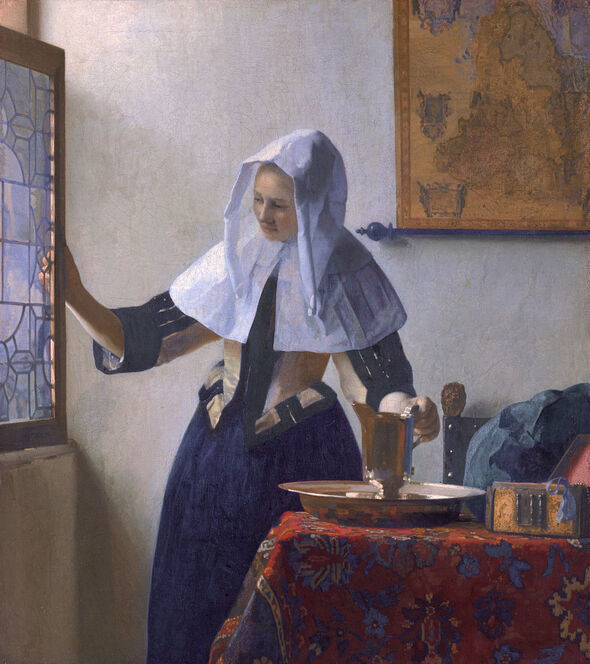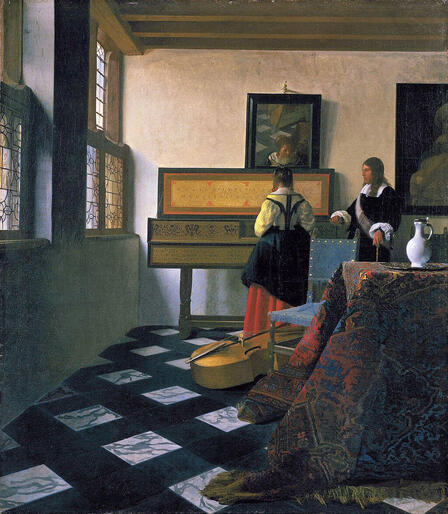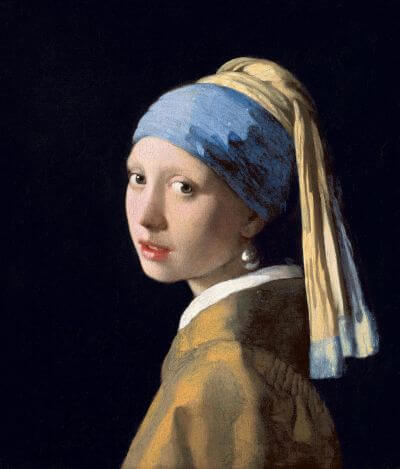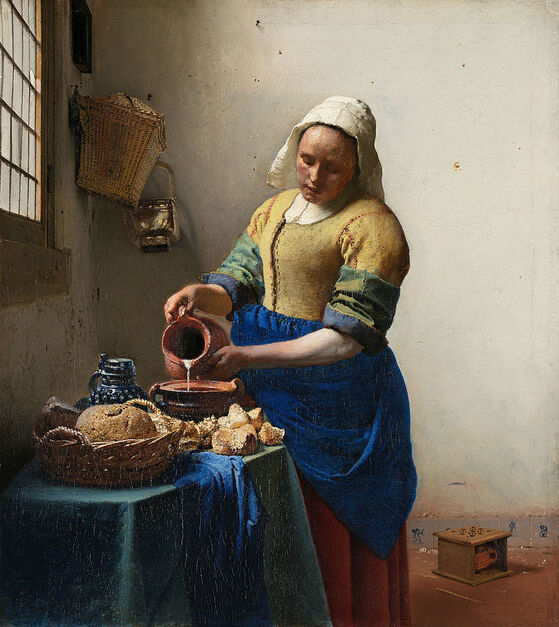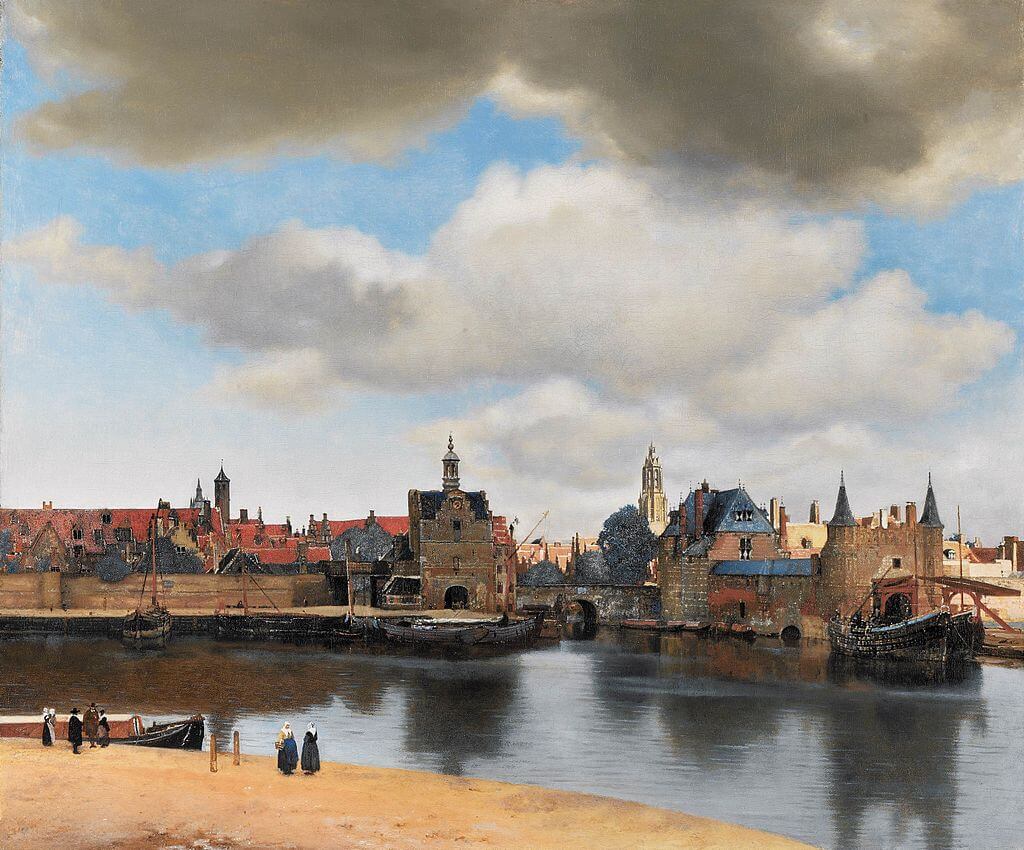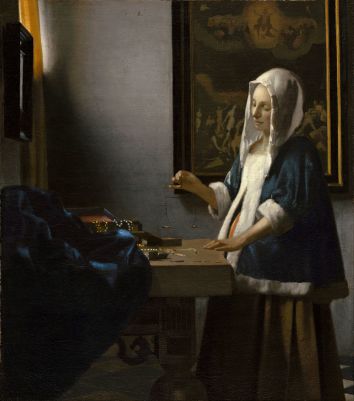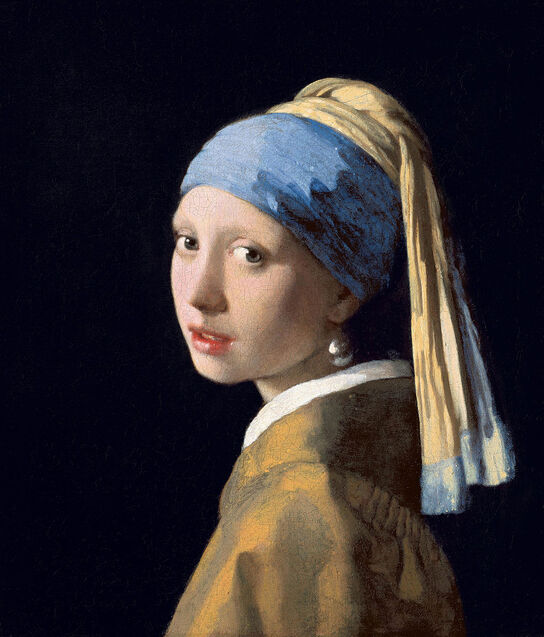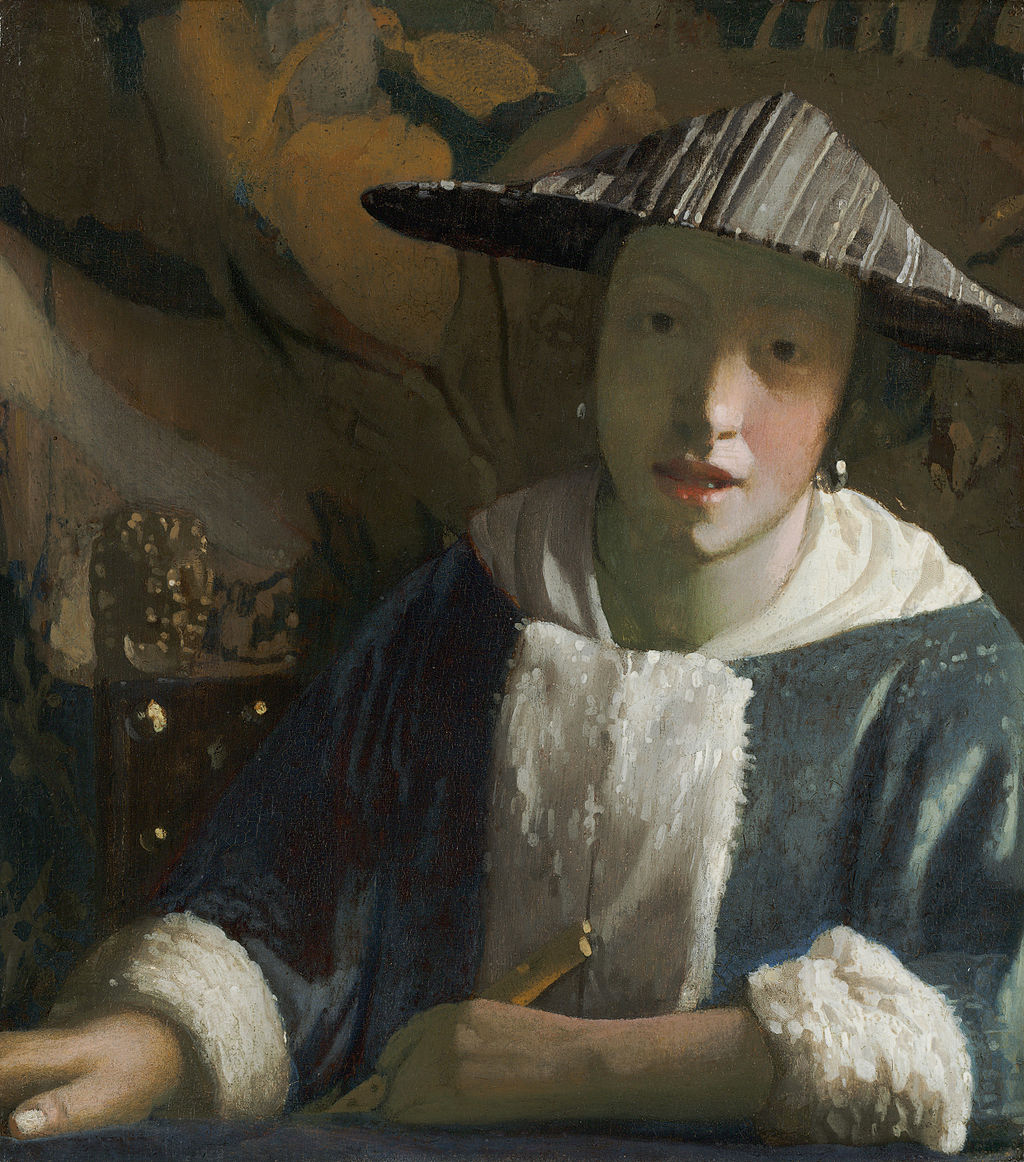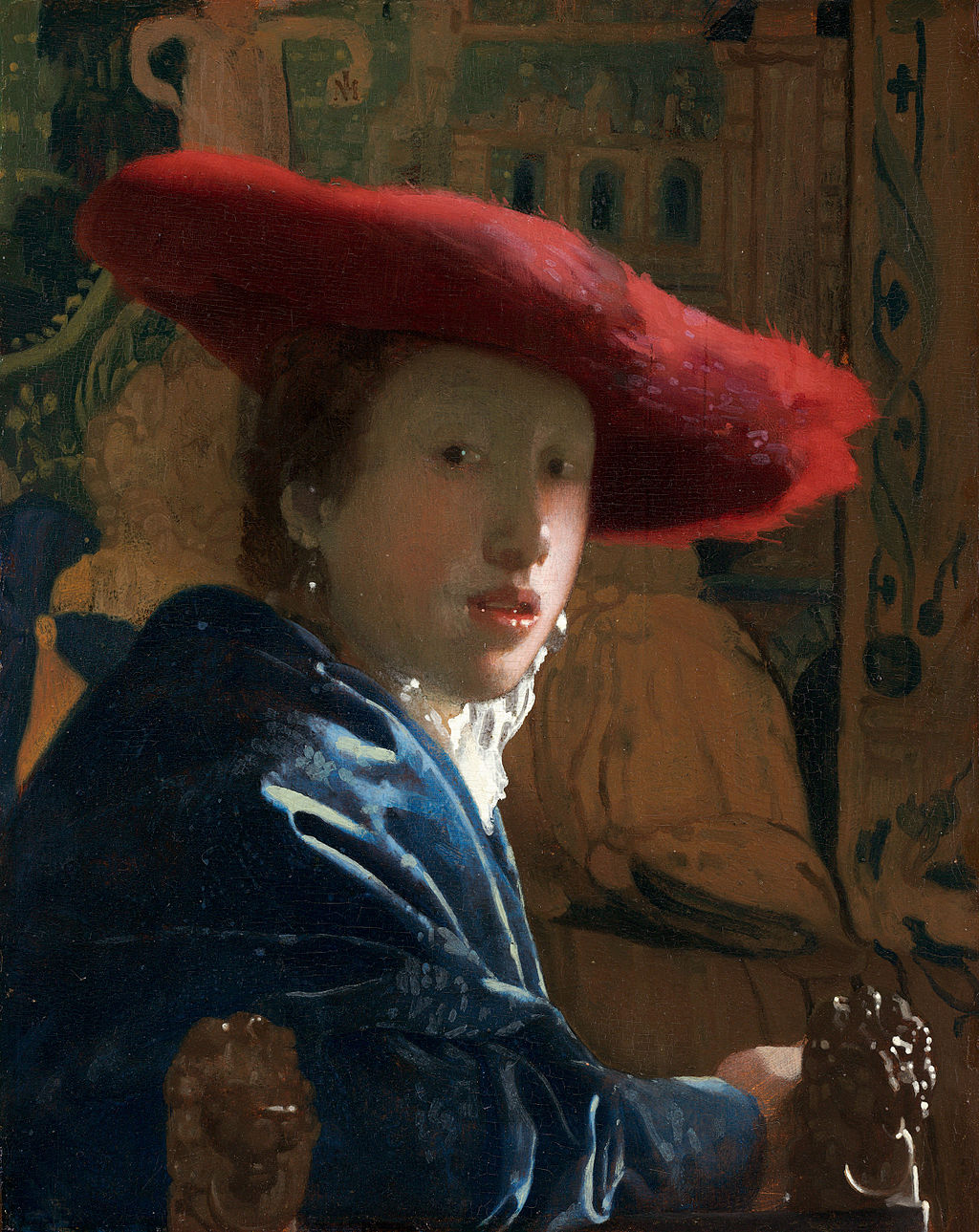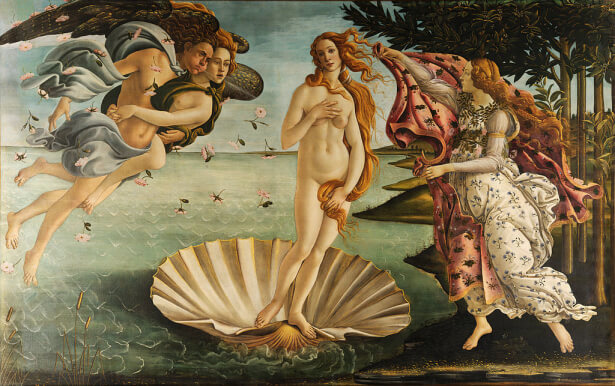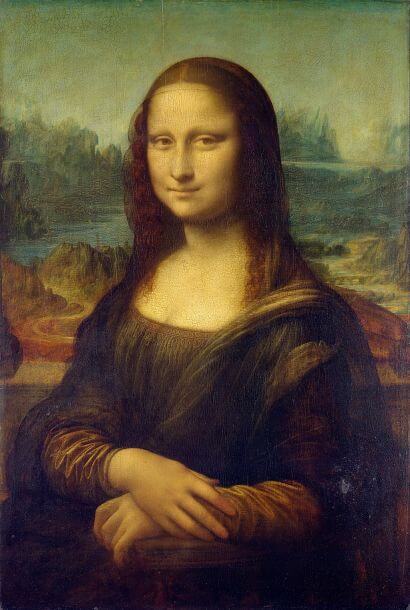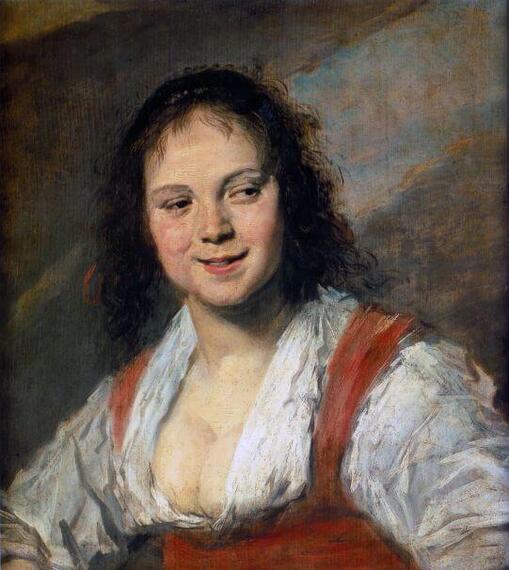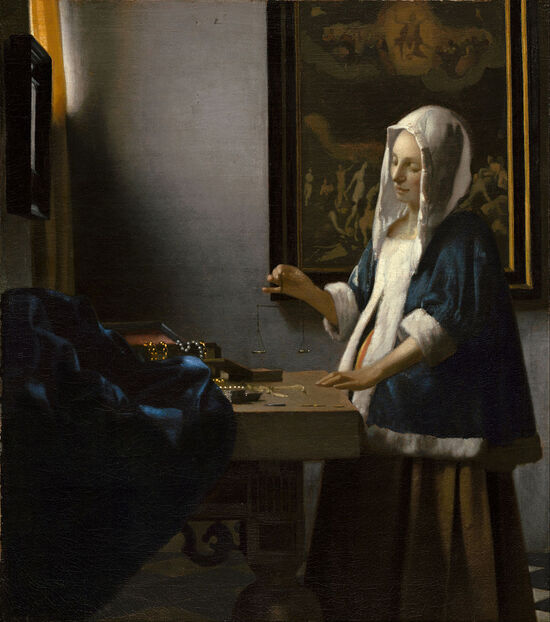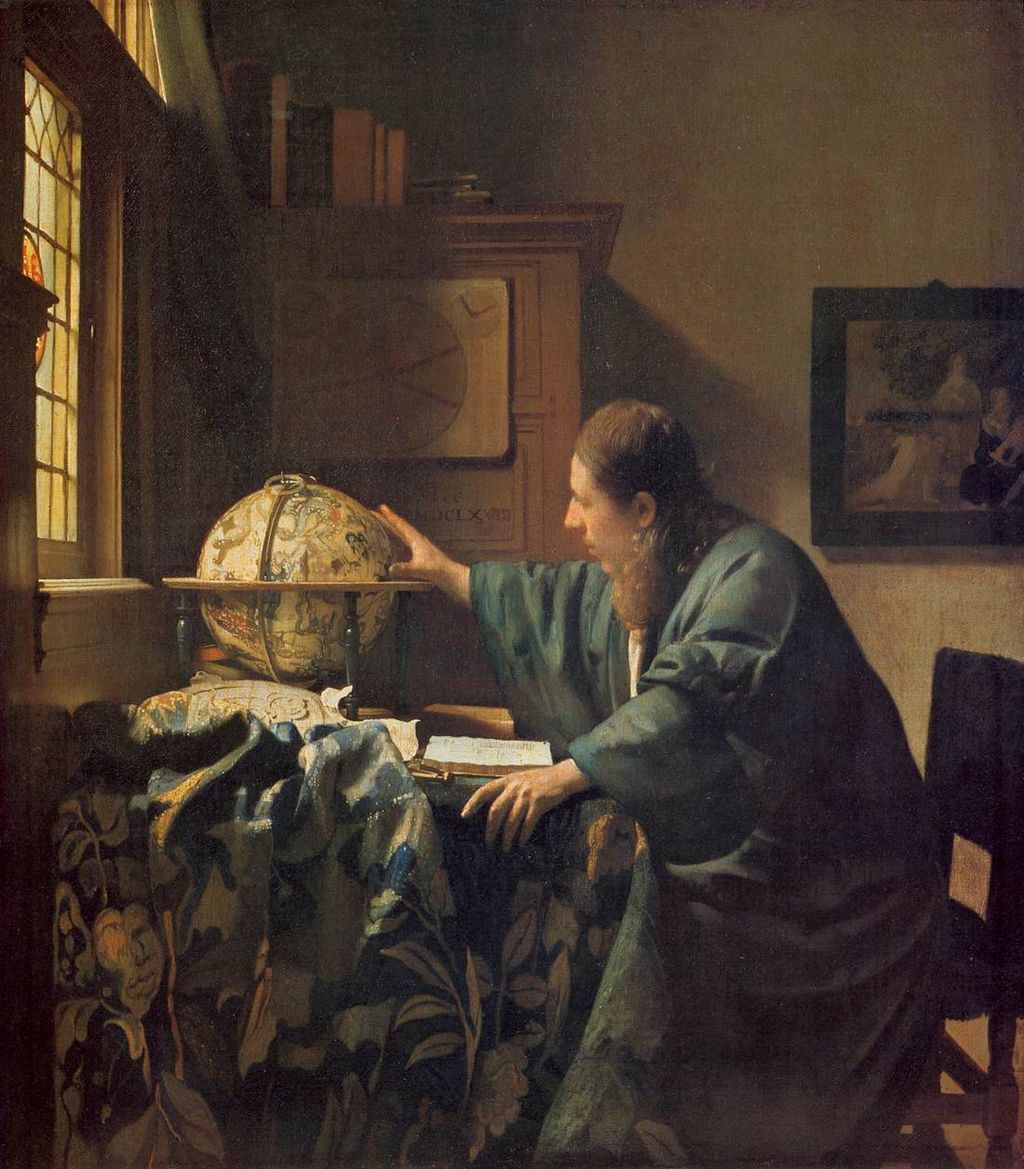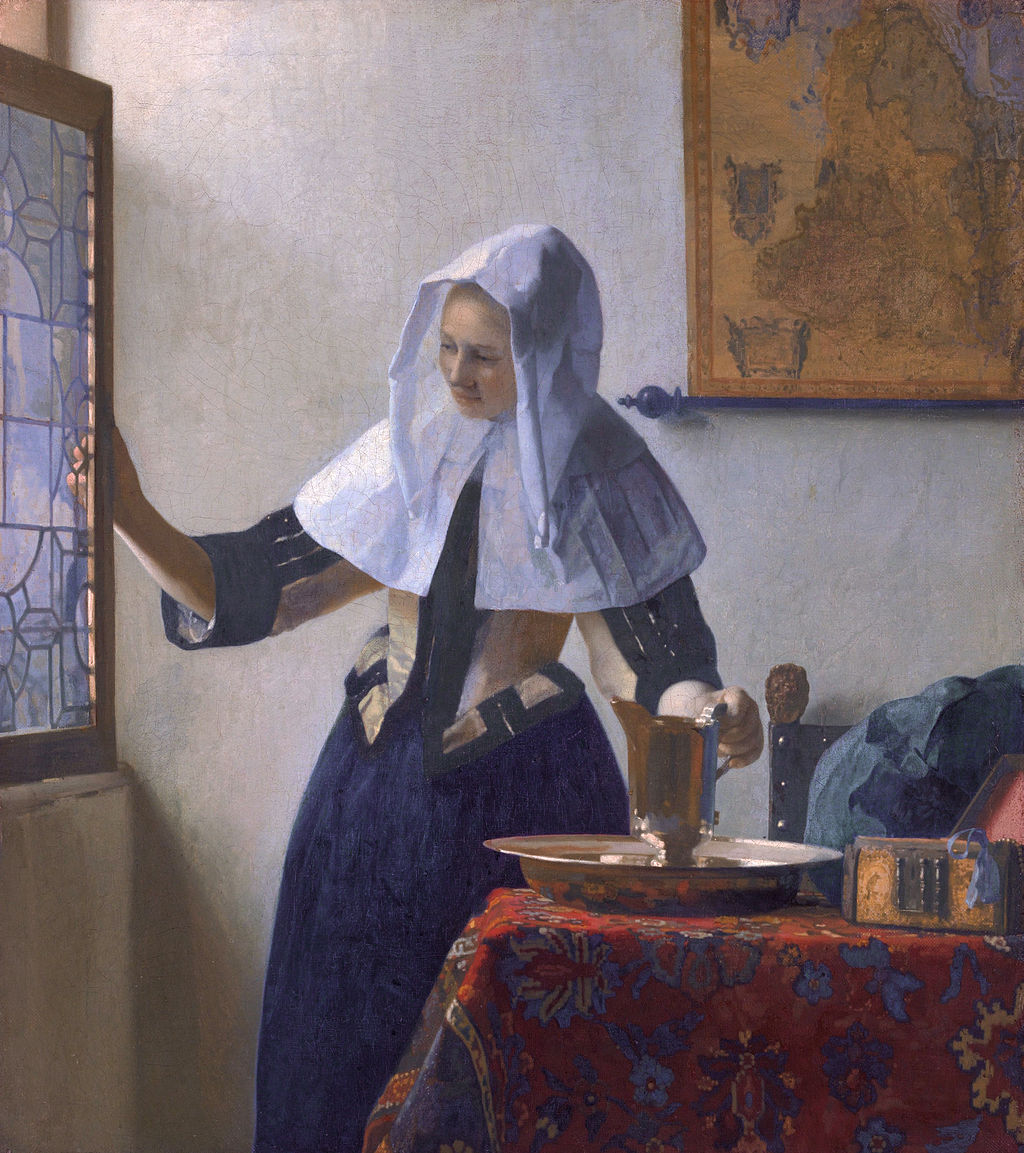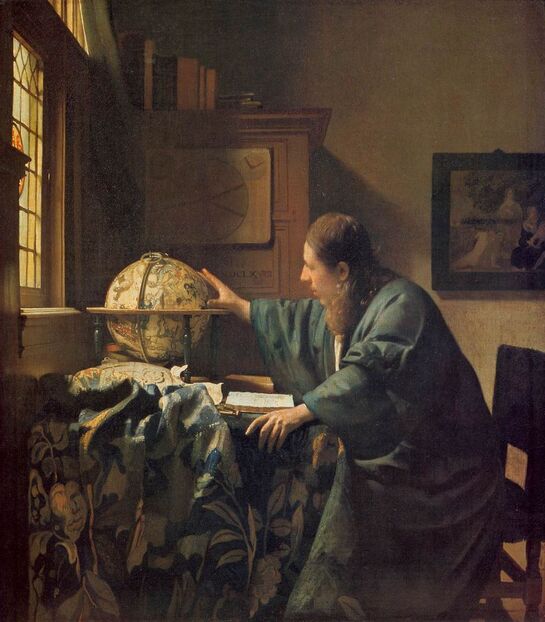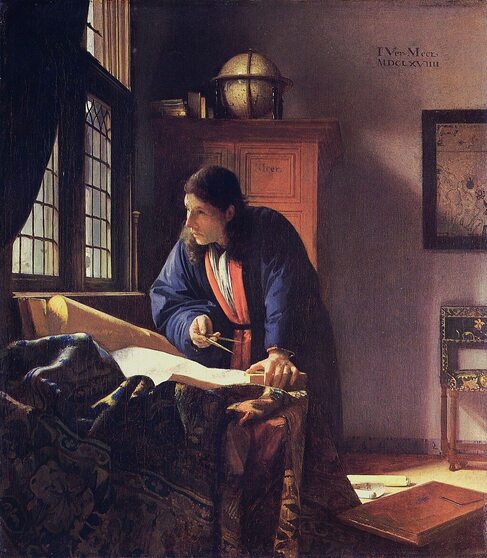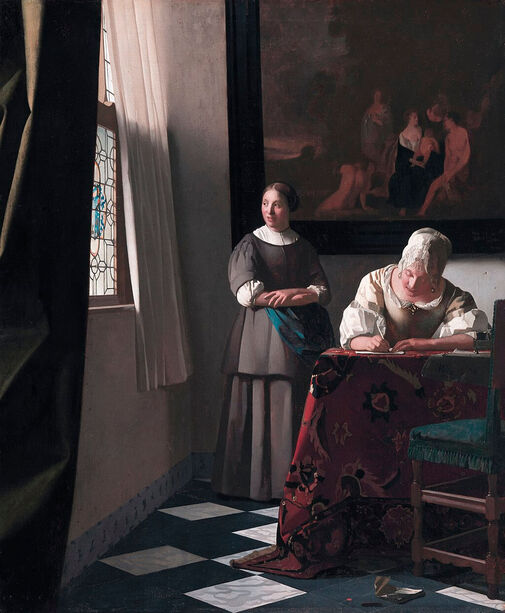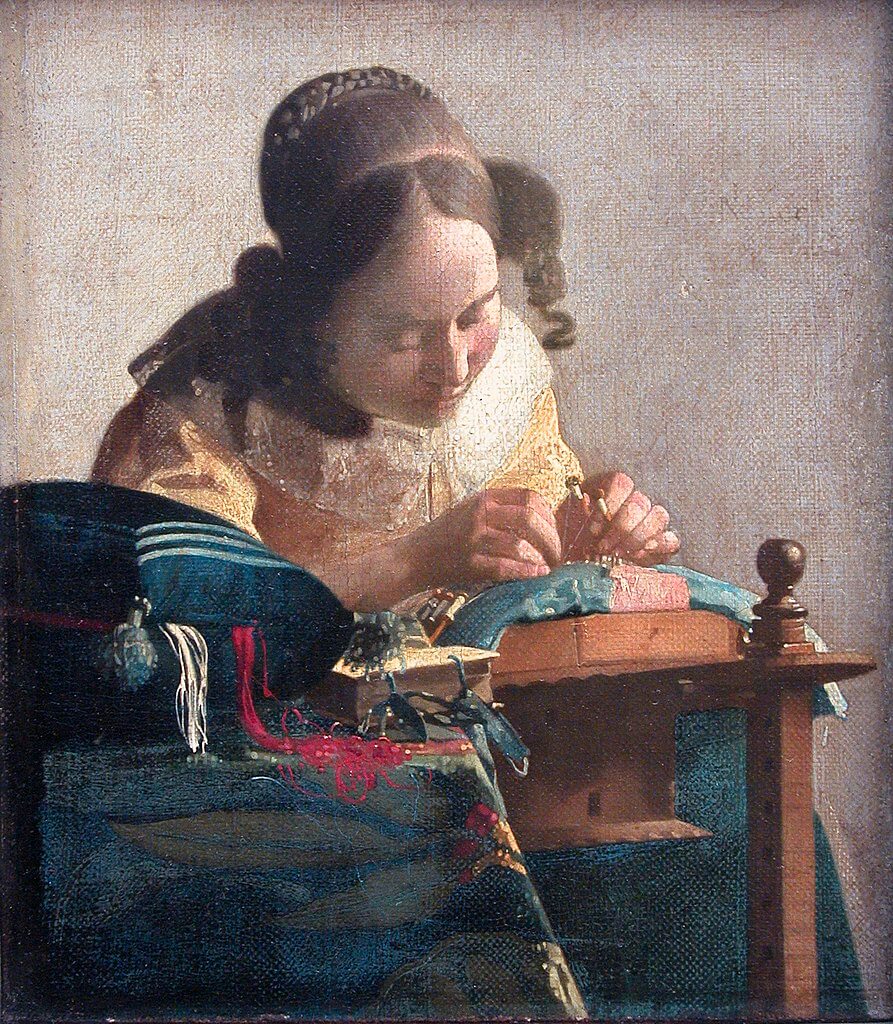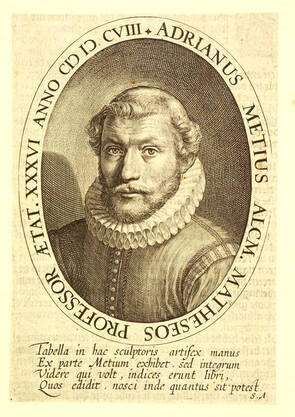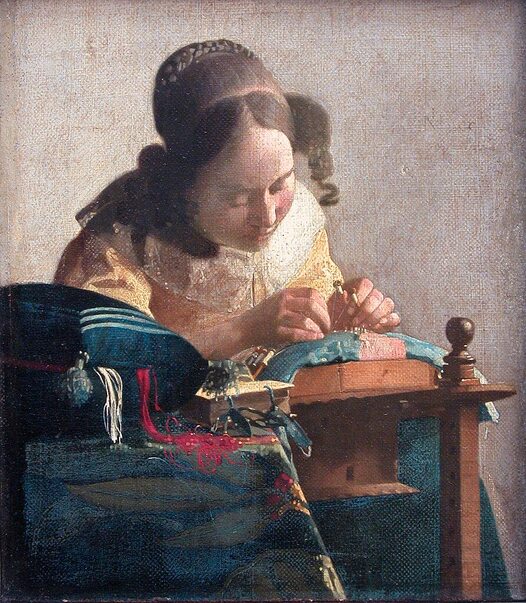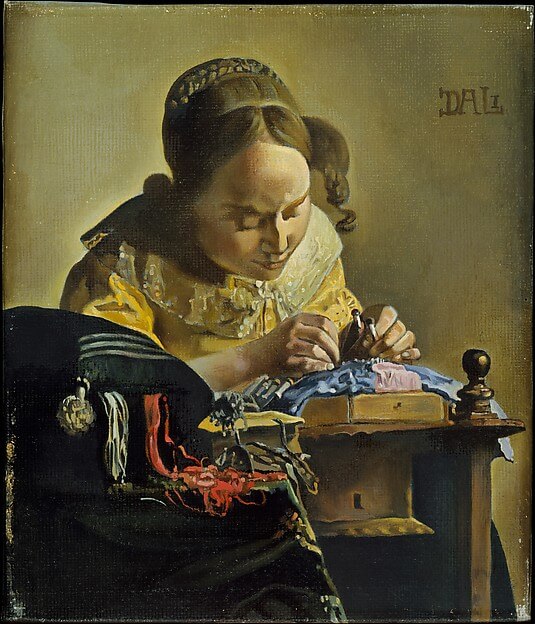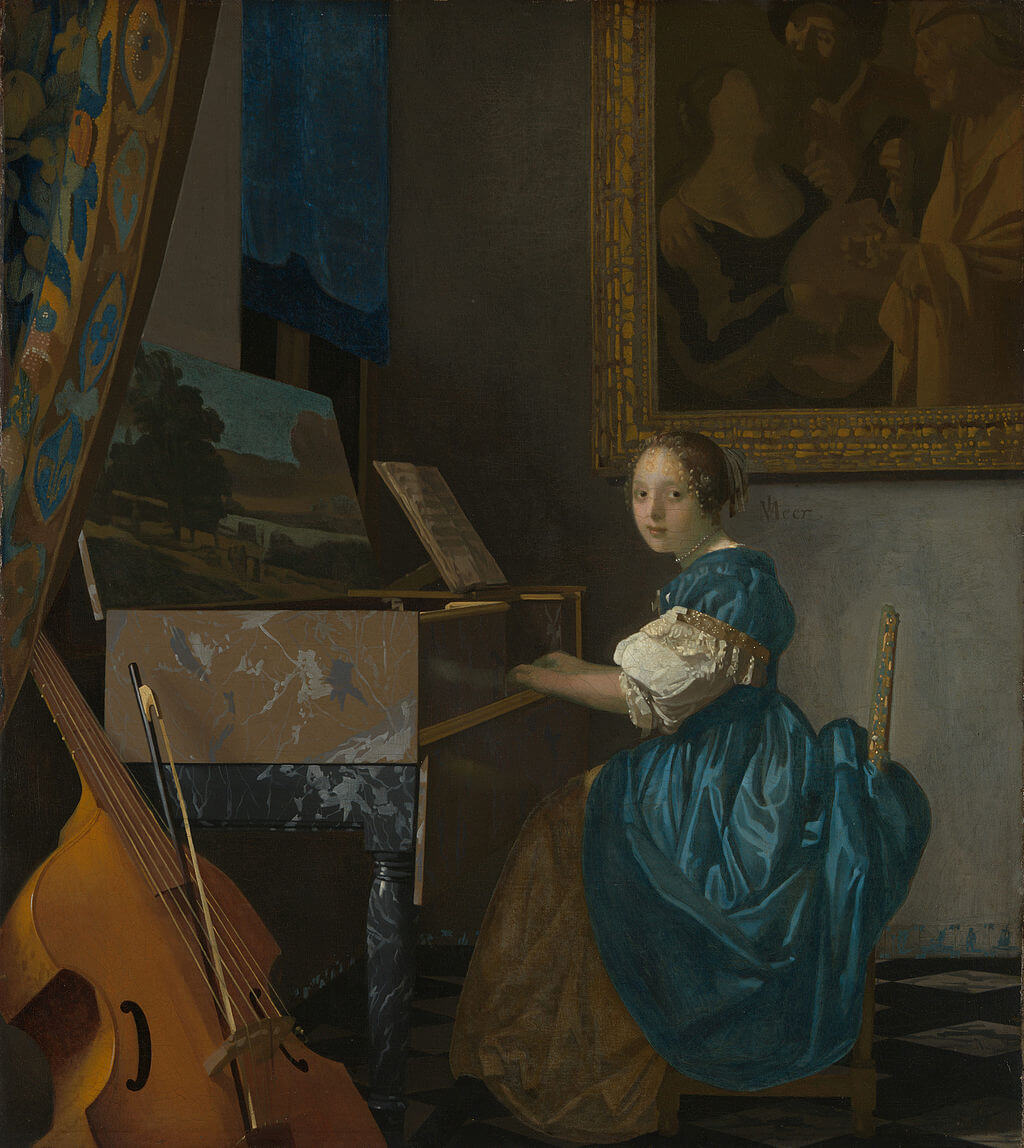|
Where? Gallery 632 of the Metropolitan Museum of Art
When? Around 1662 What do you see? A young woman opens a leaded window with her right hand, and she holds a water pitcher in her left hand. She wears a blue dress with a blue and gold-like vest (called a bodice) on top of it. She also wears a white collar and an equally white linen head covering. The silver water pitcher is standing on a silver basin. The table is covered with an expensive and colorful tablecloth with flower patterns. On the right of the table is a box with a blue ribbon and a pearl necklace. Behind the table is a chair with a carved lion on top of it. A blue cloth hangs over the chair. On the top right hangs a map of the seventeen provinces of Hapsburg Netherlands in the 17th century (interestingly, the west of Hapsburg Netherlands is shown on the top, and the north is shown on the right). The walls in this room are somewhat off-white (which is clear when seen in contrast to the head cover of the woman) and we can see the effects of the sunlight. We can recognize different shadows on the wall left of the woman, but we can, for example, also observe the shadows on the nails in the chair. The light in this painting is gently changing the colors of the various objects. It is not entirely clear what the woman is doing. It is possible that she wants to water some of the flowers that are outside the window or she may want to clean the window. Note that the window is the same as the left window in The Music Lesson by Vermeer.
Backstory: This painting is also known as Woman with a Water Jug. It is a genre painting depicting an everyday scene from the life of the 17th-century middle class in The Netherlands.
In 1887, Henry Marquand acquired this painting for $800 and later donated it to the Metropolitan Museum of Art. This was the first Vermeer painting to come to the United States. Balance and peacefulness: As in many other paintings of Vermeer, this painting shows a balanced composition which results in a very peaceful domestic scene. First, Vermeer achieves this by using a limited number of colors in this painting. He mainly uses the three primary colors: blue, red, and yellow. Second, Vermeer took many months to complete a single painting, and he added and removed various elements over that period to create the harmony that we see in this final version. For example, based on infrared technology, we know that Vermeer originally included another chair in the left foreground and the map on the wall was bigger and placed much more to the left. However, this created a more chaotic scene, and Vermeer proceeded to update the painting (check here for a virtual reconstruction of the earlier version of this painting). While removing the chair may not have been that much work, completely redoing the map on the wall on a different location was a lot of work and explains why Vermeer took such a long time to complete a painting (and the map turns out to be very accurate). Who is Vermeer? Johannes Vermeer was born in Delft, The Netherlands, in 1631 and died there in 1675. His father owned a tavern and was an art dealer. Early in his career, Vermeer got some inspiration from works by the followers of Caravaggio and especially their use of light. Vermeer developed his own style and primarily focused on genre paintings. The domestic scenes that he portrayed have become famous through their realism and excellent use of light and shadow. Besides the current painting, other examples that illustrate his brilliance are The Milkmaid in the Rijksmuseum in Amsterdam and Girl with a Pearl Earring in the Mauritshuis in The Hague. The work of Vermeer was certainly appreciated during his career, but after his death, there was a period of almost two hundred years during which his work was largely forgotten or attributed to other better-known painters. In the second half of the 19th century, his work was rediscovered and quite some well-known paintings were attributed to Vermeer.
Fun fact: As you can see in the paintings above, Vermeer used a lot of blue in his paintings. For this he used the pigment ultramarine (which is a natural pigment made from lapis lazuli). The use of this pigment differentiated him from his contemporaries as lapis lazuli was very expensive.
Most other painters used the much cheaper azurite to create blue. Lapis Lazuli is a rock with a deep blue color, and this rock was not available in Europe but had to come from countries like Afghanistan. Ultramarine is created by grinding lapis lazuli into powder and combining it with a drying oil. Titian is another well-known artist who often used ultramarine. During the Renaissance, ultramarine was primarily used to paint the robe of the Virgin Mary. The ultramarine pigment remained very expensive until 1826 when synthetic varieties of ultramarine became available. Interested in a copy for yourself? Poster
0 Comments
Where? The Eregallerij on the second floor of the Rijksmuseum
When? Between 1657 and 1661 What do you see? A milkmaid is pouring milk from an earthenware jug into an earthenware cooking pot. The table is covered with a greenish cloth, and a blue cloth is hanging down from the table. The table further contains various pieces of bread, a basket with bread, and a blue stoneware jug (note the use of small bright dots by Vermeer on the bread baskets and the bread – also referred to as the pointillé technique). The girl is possibly making bread pudding in the cooking pot. She is focused on her task, and her face is expressionless. She is dressed in a white linen cap, a yellow jacket of wool, rolled-up green and blue sleeves that are not part of her jacket, a blue apron, and a red skirt. The sunlight is entering through the window on the left. Note that one piece of the glass on the right is broken. To the right of the window hangs a basket with bread on the wall. Above the basket hangs a small painting with unknown content and to the right of the basket hangs a metal container. The large wall in the back is white (with some stains) and lit up by the sunlight which enters through the window. At the bottom of this wall is a series of typical Delft Blue tiles. In front of these tiles is a foot stove to warm the feet with nine holes on the top and a bowl inside of it. The tile on the left of the stove depicts Cupid. The tile on the right of the stove depicts a man with a long walking stick. Treatment of Light? The way that Vermeer included the effects of the sunlight in this painting is particularly noteworthy. The light is most visible when looking at the walls. The wall on the left is in the shadow, and the back wall is largely lit up. You can also see various shadows on the back wall. An obvious one is the shadow of the metal container on the left of the back wall. While the window is only partially included, we can get a good idea of its real size by looking at the presence of the shadows or the lack thereof. For example, we do not see the shadow of the milkmaid, indicating that the window does not extend much to the left. However, we can see the shadow of the nail on the top of the painting (above the right shoulder of the milkmaid) indicating that the window is quite tall. Backstory: About twenty years after the death of Vermeer, 21 of his paintings were sold at an auction. This painting was sold for 175 guilders in 1696 (which is roughly equivalent to $90 at that time). After the View of Delft painting (which is now in the Mauritshuis in The Hague), it was the second most expensive painting sold during that auction and considered to be a great piece of work. The next most expensive painting was Woman Holding a Balance which is now in the National Gallery of Art in Washington, DC. The Milkmaid was acquired in 1908 by the Rijksmuseum. Recent x-ray examinations have shown that Vermeer removed a couple of items from the painting. First, Vermeer initially included a painting on the back wall. However, as paintings were quite expensive at that time, he removed it to create an empty wall to simplify the room. Second, he also initially included a clothing basket next to the bottom right of the woman’s red skirt, but he also removed this later on. He probably removed this basket to put more emphasis on the main theme of this painting and not to distract the viewer too much.
Who is Vermeer? Johannes Vermeer (1632-1675) spend his full life in Delft in The Netherlands. He is considered to be a genre painter as he uses scenes from everyday life as the theme for his paintings. Vermeer was a perfectionist and worked for months on a single painting. His work is admired because of its great harmony. He was also an expert in incorporating light into his paintings and is sometimes referred to as the ‘Master of Light’.
While Vermeer's work was appreciated during his life, Vermeer was largely forgotten after his death. It took until the second half of the 19th century for Vermeer to be rediscovered. Especially the Impressionist painters could appreciate his usage of light, and since then Vermeer has gradually become more popular again. Without a doubt, his most famous work is the Girl with a Pearl Earring in the Mauritshuis in The Hague.
What is genre art? Vermeer is considered to be genre painter. Genre art is the depiction of scenes from everyday life, such as domestic settings, markets, and life on the streets. It evolves around depicting the common people engaged in daily activities.
Genre art was popular in the 16th and especially the 17th century in Flanders and The Netherlands. Pieter Bruegel the Elder and Jan Steen are two other examples of well-known genre painters. Fun fact: The woman in this painting is not really a milkmaid. While she is pouring milk at this particular moment, she is probably a kitchen maid or a servant. A milkmaid was actually someone who milked the cows and used the milk to produce dairy products. The term milkmaid is not to be confused with the milkman, who was someone who would deliver the milk to the houses of people. Some people interpret the milkmaid in this painting in an erotic way. During Vermeer’s time, milkmaids were often considered to be a subject of male desire and they were often sexually available to their employer. These people argue that the open jug of milk, the foot stove to warm up the feet and everything under the skirt of the milkmaid, and a Delft Blue tile depicting Cupid are all subtle signs of eroticism. Interested in a copy for yourself? Poster
Where? Room 15 of the Mauritshuis
When? Around 1665 What do you see? An unknown girl is painted against a black background. The girl is shown from the side but turns her brightly lit face towards the viewer. She is wearing a large, pear-shaped, shining pearl earring. On the top left of the pearl, the light is reflected, while at the bottom there is a less visible reflection of her white collar. The size of the pearl is similar to the size of her eye, which means that it is a very large pearl compared to the pearls we commonly see in contemporary pearls used for jewelry. Vermeer painted similar earrings in Girl with a Flute and Girl with a Red Hat, which are both displayed in the National Gallery of Art in Washington, DC. The girl in this painting is wearing exotic clothes. She wears a brown-yellow jacket with a white collar and a blue turban around her head with a yellow cloth that hangs down. Her mouth is slightly open, and her red lips contrast nicely with the color of her face. She is looking mysteriously at us. People do not agree on what emotions she expresses. For example, is she happy or is she sad? Notice also the technique of Vermeer in this painting. You can see his brush strokes in her clothing, but her face consists only of invisible brush strokes which adds to the tranquility of this painting. Vermeer included the famous reflection of light in the pearl earring, but when you look carefully, the light also reflects in her eyes and her lower lip.
Backstory: After the death of Vermeer in 1675, the painting was probably owned by Pieter van Ruijven, the patron of Vermeer. After that the ownership of the painting is unclear. However, in 1881, this painting reappeared and was sold at an auction in The Hague for two Dutch guilders and thirty cents to the art collector Arnoldus Andries des Tombe. This amount is equivalent to a bit more than $1 at that time, and this amount would be worth about $28 nowadays. The painting was in a bad state at that moment, and the painter of it was unknown. While restoring the picture, it was discovered to carry the signature of Vermeer.
In 1902, Des Tombe died, and his collection of paintings was donated to the Mauritshuis. It stayed there until 2014, but when the Mauritshuis was remodeled, the painting went on a world tour. After it came back, the Mauritshuis swore that the painting would never leave the museum again, just as, for example, The Birth of Venus by Sandro Botticelli in the Uffizi Museum and the Mona Lisa by Leonardo da Vinci in the Louvre. Nowadays, the painting is also known as the Mona Lisa of the North because of the curious expression of the girl.
Girl with a Pearl Earring in popular culture? In 1999, the author Tracy Chevalier wrote a fictional book entitled Girl with a Pearl Earring (Amazon link). This book has been inspired by Vermeer’s painting and has been sold over three million times. In 2003 the book was made into a similarly-entitled movie (Amazon link) with Scarlett Johansson and Colin Firth.
Who is Vermeer? Johannes Vermeer (1632-1675) was born in Delft in The Netherlands. He lived there his whole life. He married in 1653 with Catharina Bolenes and they got 15 children together. Vermeer took a lot of time to complete a painting, on average about four months. While he was perceived as a good painter by his contemporaries in Delft, he was largely unknown outside his hometown. Vermeer was familiar with the works of some other Dutch painters, but his work has almost not at all been influenced by foreign artists. Other well-known works of Vermeer include The Milkmaid in the Rijksmuseum in Amsterdam and View of Delft, which is also in the Mauritshuis.
Fun fact: Pearls can be found inside the shell of a mollusk. Most pearls come from oysters, but they can also come from snails. The biggest pearl in the world is about 34 kilos (75lbs). So, even though large pearls do exist, it is very likely that the girl in this painting is not wearing a pearl earring, but an earring made of some metal. The reason is the reflection of the light in the earring which would only be possible if it is made of a metal object such as tin or a mix of tin and silver.
The painting was initially known under several names, such as Girl with a Turban, but none of these names included the word pearl. However, in 1995, the Mauritshuis changed the name of the painting to the Girl with a Pearl Earring, and despite the doubt about whether it is really a pearl the Mauritshuis decided not to change its name again. Interested in a copy for yourself? Poster
Where? Gallery 50A of the National Gallery of Art
When? Between 1662 and 1665 Commissioned by? Possibly, Pieter Claesz. van Ruijven, the patron of Vermeer. What do you see? A pregnant woman stands in front of a table while holding a balance. She wears a blue winter jacket with white fur, a white head covering, and a long yellow/orange skirt. Her head is slightly tilted to the left, and she looks down at the balance in her right hand. On top of the table are two jewelry boxes, a pearl necklace, a gold chain, and some coins. The balance in the painting is empty but will be used to weigh the coins on the table. In the left foreground is a large blue cloth. The woman stands in front of a mirror. To the right of the mirror, we can see a yellow curtain that lets in a bit of light. On the wall in the back hangs a painting from The Last Judgment. The floor is covered with black and white tiles. Use of Light: The light that enters on the top left helps us to better identify the colors of the different items in the room. For example, look at the color of the woman’s skirt. If we just look at the color below her waist, it seems yellow-brown, but looking at her belly, it seems that the skirt has a much more cheerful color, more like orange-yellow. Also, look at the color of the tiles. Below the table, the colors and contrasts are vague, but on the right side, in the light, the black and white contrast in the tiles is very clear. Finally, the blue cloth in the bottom left makes it very clear how much effort Vermeer put in accurately incorporating the effects of light into his work. Backstory: This painting has also been referred to as “Woman Weighing Gold” or “Woman Weighing Pearls.” The Last Judgment painting in the background has not been identified yet, but it is probably a mannerist painting from the late 16th or early 17th century. An interesting detail here is that the bottom of that painting on the right side of the woman is lower than on the left side of the woman. Vermeer more often included works of art, like paintings or maps, from other artists in the background of his paintings. For example, The Astronomer in the Louvre has a painting of The Finding of Moses in the background, and in the background of Young Woman with a Water Pitcher in the Metropolitan Museum of Art is a known map of Hapsburg Netherlands.
Symbolism: Vermeer paints a pregnant woman with in the background a painting of The Last Judgment. This painting shows the apocalypse, the time when Jesus comes back to weigh all people on a ‘balance’ of good and bad to decide who goes to Heaven. One the left side of that painting (from our point of view) are the blessed people and on the right side are the damned people. At the same time, the woman is about to weigh some coins to judge their value.
The message of this painting is that one needs to be careful with the earthly pleasures, like jewelry and money, because after you die everyone will be judged by God. The mirror in front of the woman should remind her that she should look in the mirror to evaluate her actions based on the Christian religion. Who is Vermeer? Johannes Vermeer was born in Delft, The Netherlands, in 1632, and died there in 1675. He was the son of an art dealer and a silk weaver. Vermeer took a long time to complete each painting and was very precise. Because of this, he only produced a limited number of paintings. As a result, and in combination with raising his many children, he never got rich. Vermeer is classified as a genre painter (painting simple scenes from everyday life). While less than 40 known paintings are attributed to him, most of his works are of very high quality and very popular nowadays. Some great examples of his work are The Milkmaid in the Rijksmuseum in Amsterdam and Girl with a Pearl Earring in the Mauritshuis in The Hague.
Fun fact: The woman in this painting seems pregnant. This is best visible by looking at her belly, which is accentuated by the colorful part of the skirt. Other signs of her pregnancy are the pale color on her face and some hints of edema (which is a swelling in the legs, feet, and arms). The swelling in her hands is hard to see for the average person, but not for medically trained professionals.
While it is not known who the woman in the painting is, it is not unlikely that she is the wife of Johannes Vermeer, Catharina Bolnes, as they got 15 children together. Interested in a copy for yourself? Poster
Where? Second floor, room 837 of the Richelieu wing in the Louvre
When? 1668 What do you see? A seated man with long hair inspects an astronomical globe in front of him. Next to the globe lays an astrolabe, an instrument to make astronomical measurements. In front of the astronomer is an open book on astronomy on the table. The book is opened on a section on the stars. There are also some other books on the table, as well as a divider tool. The table is covered with a blue-green, thick tapestry with yellow flower decorations. The astronomer wears a voluminous blue cloak and gently touches the globe with his right hand. He is in the middle of his activities and Vermeer captures a frozen moment in time. It seems that he is making a discovery. The astronomer is the same person as the man in Vermeer’s The Geographer, which he painted one year later. In the background is a large closet with books on top of it. In front of the closet hangs a drawing of a chart with radial lines on it (a celestial planisphere). Below this chart is the inscription of Vermeer’s name and the date of the painting. On the right side of the wall hangs a painting on The Finding of Moses, which may be another painting by Vermeer that has gone missing. The Finding of Moses is also used in the background of Vermeer’s Lady Writing a Letter with Her Maid in the National Gallery of Ireland.
Light: The light is coming through the window on the left and Vermeer masterfully incorporates this light into the painting. The light illuminates the globe, the face and hands of the astronomer, and part of the tapestry of the table.
Backstory: This painting was sold several times together with The Geographer by Vermeer. The two paintings were probably companion pieces given the many similarities between the two (the same man, tapestry, and closet, as well as the similarity in the size and fabric of the paintings). The two professions often went together. A geographer was often also an astronomer at that time, as geography was related to the positioning of the stars. Globe makers at that time usually made both a celestial and a terrestrial globe. The terrestrial globe can be seen in Vermeer’s The Geographer. The Astronomer was considered the better of the two paintings. For example, in 1797, The Geographer was sold for an equivalent of $53 and The Astronomer for $108, both at the same auction. The painting has been in the Louvre since 1983. Who is Vermeer? Johannes Vermeer (1632-1675) was a perfectionist in his paintings and did not quickly produce his works to earn money. However, because of this, and the eleven surviving children that he had, he died as a poor man suffering from depression. He often took multiple months to finish a painting and regularly completely repainted big parts of a painting. He is known for his brilliant use of light in his works and may have been inspired by Caravaggio for that. Vermeer had a preference for females in his paintings, and this is only one of two paintings in which a solitary man was depicted (the other one being The Geographer in the Städel Museum in Frankfurt). No known image of Vermeer has ever been painted. He is mainly remembered for his genre pieces, which include The Lacemaker in the Louvre and The Milkmaid in the Rijksmuseum in Amsterdam.
Where? Second floor, room 837 of the Richelieu wing in the Louvre
When? 1669-1670 What do you see? A young woman is leaning forward and is making lace on a blue pillow. She concentrates on her work and holds two pins and two small cylinders with threads around them. She uses a lacemaking technique in which the threads on the cylinders are unrolled onto the pillow. The threads are tied into knots, each stitch is pinned temporarily, and the pins move forward as new knots are made. The woman wears a yellow dress with a white lace collar. Her hair has a couple of splits, with a braid on top, and, so-called, lovelock on her left (our right). A blue tablecloth with a large flower pattern is on top of the table. You can identify large green leaves and the yellow and red paint is part of the flowers. On top of the table is a blue pillow, which serves as a workbox for making lace. White and red threads, probably from silk, come out of the cushion on the bottom left. To the right of the pillow is a yellowish book, which is probably a Bible. Backstory: The Louvre bought this painting in 1870 for 1,254 French francs (which is equivalent to $254 at that time). It is the smallest among all paintings by Vermeer. The painting seems out of focus (even a bit abstract at places), something that Vermeer did on purpose to draw us closer to the painting to observe its details. Combined with its small size, this is indeed what many people do when looking at the painting. Salvador Dalí has made a copy of The Lacemaker which is owned by the Metropolitan Museum of Art. The Lacemaker by Vermeer is painted on a canvas with coarse fiber of 12 x 12 threads per square centimeter. Vermeer used the weave of the canvas as the wall in the background of this painting. The canvas for The Lacemaker is identical to the one Vermeer used for his Lady Seated at a Virginal in the National Gallery in London. In fact, the similarity in the canvas has helped to identify that painting as being made by Vermeer.
Who is Vermeer? Johannes Vermeer (1632-1675) was born in Leiden, The Netherlands. He was a very precise and slow-working artist, which led to paintings with great attention to detail, especially with regards to light effects, and great compositions. The light effects can also be found in this painting. Look, for example, at the sleeve on her right arm where he used simple shadows to paint the folds.
Vermeer used expensive pigments for his paintings, but only used a limited number of colors (only a total of 20 pigments have been identified across his paintings). He is well-known for using the very expensive ultramarine color in his paintings, including in this painting. Some of his most famous works include his Girl with a Pearl Earring in the Mauritshuis in The Hague and The Milkmaid in the Rijksmuseum in Amsterdam.
Fun fact: Until the 19th century, lace was very expensive and was a great way to signify wealth and fashion. Its status was comparable to owning tapestries and jewelry. Lace was often depicted in white and painters used the whitest paint to include lace in their paintings. Making lace was not easy and was often a profession which required long working hours. Alternatively, it was a way for housewives to make some extra money.
There were even quite some schools for lacemakers where two different techniques were taught. One technique was to make lace using the cylinders (called bobbins) as seen in this painting. Another technique was called needle lace where lace was created using a needle to sew the lace. The courts in many countries included lace elements in the attire of the judges, and this practice has been ongoing for centuries, though many countries have now modernized the attire of the judges. Interested in a copy for yourself? Poster |
Categories
All
|
- Home
- Blog
-
Museums
- Alte Pinakothek
- Art Institute of Chicago
- Baltimore Museum of Art
- Barber Institute of Fine Arts
- Bargello
- Barnes Foundation
- British Museum
- Church of Sant’Anastasia
- Cleveland Museum of Art
- Courtauld Institute of Art
- Detroit Institute of Arts
- Frans Hals Museum
- Galleria Borghese
- Gallerie dell'Accademia
- Getty Museum
- Guggenheim
- Hermitage Museum
- Kunsthistorisches Museum
- Kunstmuseum Basel
- Legion of Honor Museum
- Louvre
- Mauritshuis
- Metropolitan Museum of Art
- Musee d’Orsay
- Museum of Fine Arts in Boston
- Museum of Modern Art
- National Gallery in London
- National Gallery of Art
- National Museum in Poznań
- Norton Simon Museum
- Ny Carlsberg Glyptotek
- Palace of Versailles
- Palazzo Pitti
- Palazzo Vecchio
- Petit Palais
- Philadelphia Museum of Art
- Prado
- Pushkin Museum
- Ravenna Art Museum
- Rijksmuseum
- San Diego Museum of Art
- Santa Maria delle Grazie
- St. Peter's Basilica
- Städel Museum
- Statens Museum for Kunst
- Tate Britain
- Tate Modern
- Timken Museum of Art
- Uffizi
- Vatican Museums
- Wallace Collection
-
Artists
- Altdorfer
- Anguissola
- Berlin Painter
- Bosch
- Botticelli
- Boucher
- Bronzino
- Bruegel the Elder
- Brunelleschi
- Cabanel
- Caillebotte
- Canova
- Caravaggio
- Carpeaux
- Cezanne
- Cimabue
- David
- Degas
- Delacroix
- De Maria
- Donatello
- El Greco
- Fontana
- Fra Angelico
- Fragonard
- Gauguin
- Gentileschi
- Gericault
- Gonzalez-Torres
- Goya
- Hals
- Hogarth
- Hokusai
- Ingres
- Leonardo da Vinci
- Lippi, Filippo
- Longhi, Barbara
- Lorrain
- Makovsky
- Manet
- Massys
- Matisse
- Merian
- Michelangelo
- Mochi
- Modigliani
- Monet
- Panini
- Parmigianino
- Perugino
- Picasso
- Pisanello
- Raphael
- Rembrandt
- Renoir
- Reynolds
- Rivera
- Rodin
- Rubens
- Scultori
- Seurat
- Steen
- Tintoretto
- Titian
- Toulouse-Lautrec
- Turner
- Uccello
- Van der Weyden
- Van Dyck
- Van Eyck
- Van Gogh
- Van Hemessen
- Vasari
- Velazquez
- Vermeer
- Veronese
- Vigée Le Brun
-
Locations
- Books
- About Us

